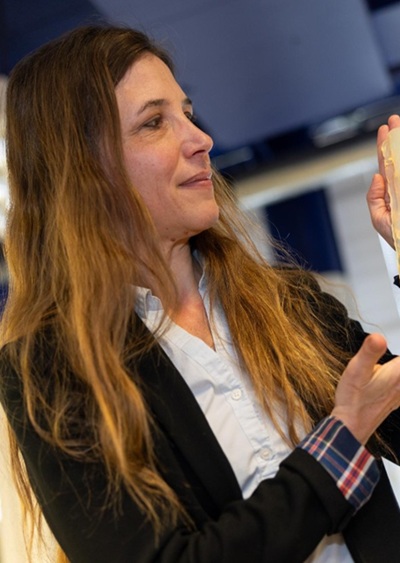
Anastasia Katsarelia, Researcher, Forest scientist -Environmentalist
Elpida Peroulaki, Environmental Engineer, N.EN.CL.C.A. (Natural Environment and Climate Change Agency) – Management Unit of Samaria National Park & Western Crete Protected Areas
Antonios Barnias, Forest scientist, N.EN.CL.C.A. – Head of the Management Unit of Samaria National Park & Western Crete Protected Areas
The olive groves, apart from their value for the folk history and the traditional landscape of the area, are an important habitat for various species, including the Cretan ibex.
The importance of olive groves. The distribution, number, age and size of olive trees. The construction of bench terraces on the slopes. The difficulty of cultivation and harvesting. Their importance as a habitat for the Cretan ibex and other species of wild fauna and flora.
By entering the core of the White Mountains National Park, the visitor will be impressed by the rare beauty of the landscape with the imposing pines and cypresses, the running waters and the steep rocks that rise on the slopes. However, within this unique, natural, and, at first glance, wild environment, the human element coexists.
Before the declaration of the area as a National Park in 1962, there was a daily human presence in the Samaria gorge. There lived the residents of the settlements of Samaria and Ano Agia Roumeli who, among other activities of their daily life, cultivated olive trees. These trees, even today, cover a significant part of the slopes of the gorge, near the abandoned settlements, now coexisting with towering pines and cypresses. One first encounters these when descending from Xyloskalo, in the area of the church of Agios Nikolaos, and then again around and further south of the settlement of Samaria, where the largest numbers of them are found. They grow in the lowlands, next to the river, but also higher on the slopes.

Mapped areas of olive and fruit trees on a satellite background.

Old settlement of Samaria and abandoned olive groves
Today, the majority of the olive trees grow under the dense canopies of the pines and the cypresses, with the result that the wide area they occupy is not easily perceived. Apart from the few flat areas, most of the olive trees grow on slopes which have been formed to stone-built bench terraces. It is remarkable that, despite the steep slopes, every possible available area of earthy soil around the old settlement had been used to form terraces or enclaves of individual trees.
The variety of olive trees found within the gorge is the Tsunati. The trees grow to heights of up 6-8 meters. This variety is resistant to cold and is cultivated at altitudes of up to 1,000 meters (GAIApedia, 2017, Hellenic Ministry of Rural Development and Food, 2020).
The olive groves of Samaria attracted the interest of the well-known nature lover Plymakis Antonis, today honorary president of the Mountaineering Association of Chania, who, as he cites in his book Memories of Samaria (2010), in 1962, when the area was expropriated, a total of 1200 olive trees were counted in the area of the settlements of Samaria and Ano Agia Roumeli.

Olive trees on stone-built bench terraces.

Olive tree in a stone-built enclave.
The olive groves, apart from their value for the folk history and the traditional landscape of the area, are an important habitat for various species of flora and fauna, including the Cretan ibex (the residents call them “agrimia” (wild animals)).

Adult (female) and juvenile Cretan ibex feeding on fallen leaves inside the settlement of Samaria (October 2020).
Finally, it is worth noting that the value of the olive groves of Samaria has also been recognized by the Council of Europe. In the recent decision concerning the conditions for the renewal of the European Diploma for Protected Areas, one clearly defined condition is the design and implementation of measures to stop the observed invasion of pine trees into the old olive groves opposite to the settlement of Samaria (recommendation 3) (Council of Europe, 2019).
With the aim of improving the condition of the olive groves and orchards located around the old settlement of Samaria, the Natural Enviroment & Climate Change Agency (N.E.C.C.A.) implemented in the period 2020-2021 the action “Advisory support for the improvement of the habitat suitability of fauna species in the Samaria National Park”, funded by the Business Plan “Transport Infrastructures, Environment and Sustainable Development”, ESIF 2014-2020, with the collaboration of the Forest scientist-Environmentalist and researcher Katsarelia Anastasia, who was in charge of this project.
During the record keeping of 2021 the large number of olive trees was confirmed, and their age was estimated. The calculation of the age of old olive trees is usually done by the radio dating method, which in combination with the classic method of measuring the annual rings provides quite accurate results (Camarero et al., 2021). A common method, however, used for rough estimates, is based on the elements of the perimeter, or on the maximum radius of the central solid trunk, after the determination the average annual rate of radial growth of the olive tree (Gianniris, 2019; Association of olive tree cultivation municipalities of Crete (without date); Tsarouha, 2011 from Michelakis, 2002). Due to their size, shape and other characteristics, most of the trees in the study area

Several centuries old olive trees

Several centuries old olive trees
appear to have a very long lifetime, which for many of them seems to span over several centuries. There are olive trees with a diameter of 80 cm, and even some species with a diameter of >1 m. Based on the aforementioned methodology, olive trees with diameters of 80-110 cm are estimated to be 500-700 years old.
As expected, according to the applied methodology (partition of olive groves in sampling areas (s.a.) and examination of the individual tree characteristics as: canopy-leaf density; symptoms of nutrient deficiency; damages on the trunks or on the branches; amount of flowering; density estimation of the forest vegetation in each s.a.; soil analyses) and the subsequent evaluation of the field data, it was shown that the general condition of the trees is unsatisfactory. The major problem is the intrusion mainly of pines, and secondarily of cypresses and hollies, into the olive groves. The fact that the soil surface of these areas is covered by pine needles almost by 100% and it contains dense clusters of forest trees, leads to conditions of increased soil acidity, as well as to reduced photosynthetic function of the plant species within the cluster due to shading. As a result, the regeneration of any kind of flora, be it herbaceous, briny, bushy or woody, becomes difficult, while the existing species of the sublevel, such as the olive trees, face adverse growth conditions. In this type of surfaces there is little regeneration of cypresses, and almost no regeneration of pines, other shrubs, brambles, and herbaceous plants.
Finally, the project examined measures that can be taken to preserve the olive groves, considering the institutional framework of the protected area. These actions include cultivation measures for the care of the olive trees, including the removal of competitive vegetation.
The immediate plans of N.E.C.C.A. include the utilization of the results of this research for the implementation of mild interventions, aiming at highlighting and promoting the abandoned olive groves, nut also preserving, both, an important type of habitat of the wild fauna of the National Forest, as well as the memories of the people who lived earlier in the area and their daily toil for survival under adverse conditions, with respect to and in harmony with nature.
This work was implemented as part of Sub-project 1 of the Action “Management Actions of Protected Areas, Species and Habitats in the area of responsibility of the former Management Unit of Samaria National Park & Western Crete Protected Areas and it was co-financed by the European Structural and Investment Funds of the European Union and national resources through the Business Plan “Transport Infrastructures, Environment and Sustainable Development”, ESIF 2014-2020 (project code; 5033240).
Bibliographic sources:
- Camarero, J. J., Colangelo, M., Gracia-Balaga, A., Ortega-Martínez, M. A., & Büntgen, U. (2021). Demystifying the age of old olive trees. Dendrochronologia, 65. https://doi.org/10.1016/j.dendro.2020.125802
- Council of Europe (2019). Resolution CM/ResDip(2019)9 on the renewal of the European Diploma for Protected Areas awarded to the Cretan White Mountains National Park, Samaria (Greece) (Adopted by the Committee of Ministers on 21 November 2019 at the 1361st (Budget) meeting of the Ministers’ Deputies). Available at: https://search.coe.int/cm/Pages/result_details.aspx?ObjectId=090000168098d07e
- Yanniris, H. (2019). A first estimate of the age of centuries-old olive trees in Ikaria, compared to other Mediterranean regions (Lakonia, Portugal, Corfu, Italy, Crete, Cyprus).
Available at the email address;
https://www.academia.edu/41079477/Μια_πρώτη_εκτίμηση_της_ηλικίας_αιωνόβιων_ελαιοδέντρων_στην_Ικαρία_σε_σύγκριση_με_άλλες_μεσογειακές_περιοχές_Λακωνία_Πορτογαλία_Κέρκυρα_Ιταλία_Κρήτη_Κύπρο
- Katsarelia, A. (2021) “Advisory support for the improvement of the suitability of the habitat of fauna species in the Samaria National Forest”, Sub-project 1 “Development and protection of Western Crete Natura 2000 Network areas” of the action “Grant of the Samaria National Forest Management Unit for management actions for protected areas, species and habitats” Phase A “Recording of the current situation of olive groves and orchards of the Samaria Gorge”, deliverable I. Management Unit of Samaria National Park & Western Crete Protected Areas. Funded under the Business Plan “Transport Infrastructures, Environment and Sustainable Development”, ESIF 2014-2020.
- Katsarelia, A. (2021) “Advisory support for the improvement of the suitability of the habitat of fauna species in the Samaria National Forest” of Sub-project 1 “Development and protection of Western Crete Natura 2000 Network areas” of the action “Grant of the Management Unit of Samaria National Park for management actions for protected areas, species and habitats”, Phase B “Proposed management measures to improve olive groves and orchards of the Samaria Gorge”, deliverable II. Management Unit of Samaria National Park & Western Crete Protected Areas. Funded under the Business Plan “Transport Infrastructures, Environment and Sustainable Development”, ESIF 2014-2020.
- Pambouhidou, G., Mastoideis; The second oldest olive variety in Greece. Available at the email address; https://www.olivenews.gr/el/episthmh/kalliergeia/mastoeidis-i-deyteri-archaioteri-poikilia-elias-ston-elladiko-choro
- Plymakis, A. (2010). Memories of Samaria. The gorge and its people over the centuries.
- Association of olive tree cultivation municipalities of Crete (without date). Age determination. Project title: The olive culture from Crete to Cyprus. INTERREG IIIA program Greece – Cyprus 2000-2006. Available at the email address; http://polelia.sedik.gr/age.html
- Tsarouha, E. (2011). Analysis and evaluation of the landscape of ancient olive groves in the Mediterranean. Protecting, preserving, and developing these as protected areas. Master thesis. Available at the email address; http://ikee.lib.auth.gr/record/128426/files/tsaroucha.pdf
- Ministry of Rural Development and Food (2020). Product specifications, EC Regulation Nr. 1151/2012 of the Council. Available at the email address http://www.minagric.gr/images/stories/docs/agrotis/POPPGE/2020/prodiagrafes_kriti_070920.pdf








Leave A Comment